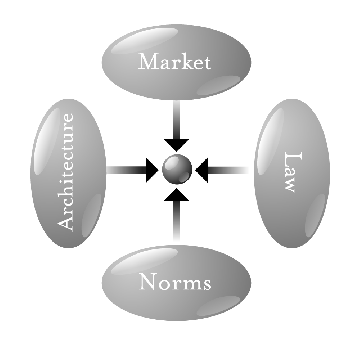Pathetic dot theory on:
[Wikipedia]
[Google]
[Amazon]
 The pathetic dot theory or the New Chicago School theory was introduced by
The pathetic dot theory or the New Chicago School theory was introduced by
Code 2.0, Chapter: What Things Regulate
(available in print: ) *{{cite journal, last=Basham, first=Matthew J., author2=Stader, David L. , author3=Bishop, Holly N. , title=How "Pathetic" is Your Hiring Process? An Application of the Lessig "Pathetic Dot" Model to Educational Hiring Practices, journal=Community College Journal of Research and Practice, date=February 10, 2009, volume=33, issue=3–4, pages=363–385, doi=10.1080/10668920802564980 Social theories Regulation Internet governance
 The pathetic dot theory or the New Chicago School theory was introduced by
The pathetic dot theory or the New Chicago School theory was introduced by Lawrence Lessig
Lester Lawrence Lessig III (born June 3, 1961) is an American academic, attorney, and political activist. He is the Roy L. Furman Professor of Law at Harvard Law School and the former director of the Edmond J. Safra Center for Ethics at Harvard ...
in a 1998 article and popularized in his 1999 book, '' Code and Other Laws of Cyberspace''. It is a socioeconomic
Socioeconomics (also known as social economics) is the social science that studies how economic activity affects and is shaped by social processes. In general it analyzes how modern societies progress, stagnate, or regress because of their l ...
theory of regulation
Regulation is the management of complex systems according to a set of rules and trends. In systems theory, these types of rules exist in various fields of biology and society, but the term has slightly different meanings according to context. Fo ...
. It discusses how lives of individuals (the pathetic dots in question) are regulated by four forces: the law
Law is a set of rules that are created and are enforceable by social or governmental institutions to regulate behavior,Robertson, ''Crimes against humanity'', 90. with its precise definition a matter of longstanding debate. It has been vario ...
, social norms
Social norms are shared standards of acceptable behavior by groups. Social norms can both be informal understandings that govern the behavior of members of a society, as well as be codified into rules and laws. Social normative influences or soci ...
, the market
Market is a term used to describe concepts such as:
*Market (economics), system in which parties engage in transactions according to supply and demand
*Market economy
*Marketplace, a physical marketplace or public market
Geography
*Märket, an ...
, and architecture (technical infrastructure).
Theory
Lessig identifies four forces that constrain our actions: the law, social norms, the market, and architecture. The law threatens sanction if it is not obeyed. Social norms are enforced by the community. Markets through supply and demand set a price on various items or behaviors. The final force is the (social) architecture. By that Lessig means "features of the world, whether made, or found"; noting that facts like biology, geography, technology and others constrain our actions. Together, those four forces are the totality of what constrains our action, in fashion both direct and indirect, '' ex post'' and ''ex ante
The term ''ex-ante'' (sometimes written ''ex ante'' or ''exante'') is a phrase meaning "before the event". Ex-ante or notional demand refers to the desire for goods and services that is not backed by the ability to pay for those goods and servic ...
''.
The theory has been formally called by Lessig in 1998 "The New Chicago School", and can be seen as a theory of regulation.
The theory can be applied to many aspects of life (such as how smoking is regulated), but it has been popularized by Lessig's subsequent usage of it in the context of the regulation of the Internet. Lessig noted that the key difference in regulation of the Internet ( cyberspace), compared to regulation of the "real world" ("realspace"), is the fact that the architecture of the internet – the computer code
A computer is a machine that can be programmed to carry out sequences of arithmetic or logical operations ( computation) automatically. Modern digital electronic computers can perform generic sets of operations known as programs. These pr ...
that underlies all software
Software is a set of computer programs and associated software documentation, documentation and data (computing), data. This is in contrast to Computer hardware, hardware, from which the system is built and which actually performs the work.
...
– is created by humans, whereas in the real world much of the architecture, based on laws of physics, biology, and major social and cultural forces, is beyond our control. Lessig sees code as an important force that should be of interest to the wider public, and not only to the programmers. He notes the importance of how technology-mediated architecture, such as coded software, can affect and regulate our behavior. Lessig wrote:
See also
* Chicago school of economicsReferences
Further reading
*Lessig, LawrenceCode 2.0, Chapter: What Things Regulate
(available in print: ) *{{cite journal, last=Basham, first=Matthew J., author2=Stader, David L. , author3=Bishop, Holly N. , title=How "Pathetic" is Your Hiring Process? An Application of the Lessig "Pathetic Dot" Model to Educational Hiring Practices, journal=Community College Journal of Research and Practice, date=February 10, 2009, volume=33, issue=3–4, pages=363–385, doi=10.1080/10668920802564980 Social theories Regulation Internet governance